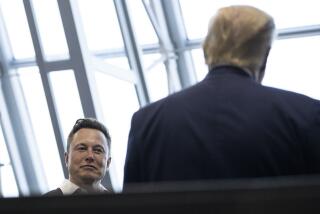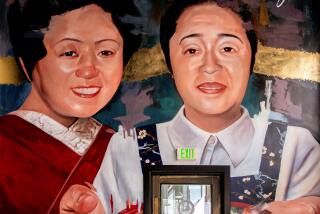Shinsei Shows Japan How to Bank the American Way
- Share via
Paul Volcker, David Rockefeller, John Reed and Vernon Jordan walk into a bank in Tokyo.
But this is no joke. These titans of politics and business -- along with GE Capital, Citigroup, Mellon Financial and a few other high-rolling U.S. investment firms -- are directors, advisors or investors in a Japanese financial institution called Shinsei that aims to show the country how banking should be done.
It could sure use the lesson. As noted in this space Sunday, the Japanese financial system is a mess. Shinsei, which means “new birth,” is setting a daring, and successful, pace for change. And a lot is riding on whether its example is followed.
Shinsei was born three years ago, when two New York private equity investment firms, Ripplewood Partners and JCF Co., organized a group that purchased Long Term Credit Bank of Japan, a revered and once-thriving institution.
In the 1950s, government-owned Long Term Credit had made low-interest loans to farmers and small manufacturers and was one of the linchpins of Japan’s postwar economic recovery. But by the late 1990s, it had fallen victim to Japan’s financial crisis, piling up almost $50 billion in problem loans. Tokyo decided to sell the remains of Long Term Credit for $8 million -- plus the investors’ pledge to invest $1 billion to make the bank right.
Some of the Americans in the deal saw a moneymaking opportunity in an institution that had unmatched contacts in every corner of Japanese industry. But others saw a chance to help Japan see the wisdom of free enterprise. “There was a lot of idealism in the effort,” says one of the bank’s U.S. directors.
According to “Saving the Sun,” by Gillian Tett, a forthcoming book on the Long Term Credit episode, this group -- including Volcker, a former Federal Reserve chairman; Rockefeller, once head of Chase Bank; Reed, the onetime leader of Citibank; and Jordan, a presidential confidant and financier -- reckoned that a new kind of Japanese bank run along U.S. business principles “could be a catalyst to end the paralysis in Japan’s financial world.”
The idea was to teach Japan the American way of banking: U.S. banks are businesses. If borrowers can’t repay loans, they sell assets to raise cash, give property to the bank or declare bankruptcy.
In Japan, banks are widely regarded as government-guided financiers of industry. If loans can’t be repaid, they’re just renewed to keep production lines running and workers employed. By the late ‘90s, that attitude had led to crippled banks and a nation in frequent recession.
At Shinsei, American idealism has had several rude awakenings, and so has Japanese culture. But most important, the bank has been successful. And what started partly as idealism could turn out to be a very good business investment.
Shinsei, in the fiscal year that ended March 31, turned a profit of $450 million. It has subdued many of its bad loans, partly by handing them back to the Japanese taxpayers. It also has pioneered new ways, new for Japan, to make money in retail banking and corporate financing.
That wasn’t easy. As soon as Shinsei pressured companies to pay loans, businessmen complained to politicians, and Shinsei Chairman Masamoto Yashiro was hauled before parliamentary hearings and accused of not running the bank in line with Japanese ways.
Yashiro, who had come out of retirement to head Shinsei, fought back, insisting on following a nontraditional course. He won grudging permission to keep Shinsei on its unusual course.
“I doubt very much that Shinsei will be regarded as a model for Japanese banking,” Yashiro says with a laugh today. “They are too proud of themselves to regard us as an example.”
Nonetheless, other banks, regulators and businesses in Japan have had to pay attention to Shinsei -- because customers like what it’s doing.
The bank offers free access to automated teller machines 24 hours a day, while most of its rivals charge withdrawal fees, and online banking convenience that many clients say works smoothly. “We do not have a mainframe computer but a Microsoft Windows system that allows us to have a decentralized operation,” says Yashiro, whose previous business career was with Exxon and then Citigroup in Tokyo.
One of his newest ideas is the flexible account, which serves simultaneously as a savings and checking account as well as an investment account for yen and other currencies. Such ideas are elementary in U.S. and European banks but innovations in Japan.
To industrial clients, Shinsei offers a range of equity and debt financing services. That is happening just as Japan’s companies are reducing reliance on most other banks -- many of which have little to lend -- and increasing financing through securities markets.
Next could come the big money: Shinsei is going to make an initial public offering of 20% of its shares in January at a hoped-for price of $2 billion. That would put a total value on Shinsei of $10 billion, providing a good profit not only to the U.S. investors but also to the Japanese government, which holds a 33% stake.
As ever with Shinsei, the profit would be only part of the payoff. The hope remains that its success will persuade Japan’s business and government elites to truly support change. No one is more emphatic in that hope than Yashiro, now 74 and soon to retire again.
“If we don’t change, we will keep slowly declining as a nation,” Yashiro says in “Saving the Sun.” “We will end up in 15 years being just an eastern province of China.”
*
James Flanigan can be reached at jim.flanigan@latimes.com.
More to Read
Inside the business of entertainment
The Wide Shot brings you news, analysis and insights on everything from streaming wars to production — and what it all means for the future.
You may occasionally receive promotional content from the Los Angeles Times.










